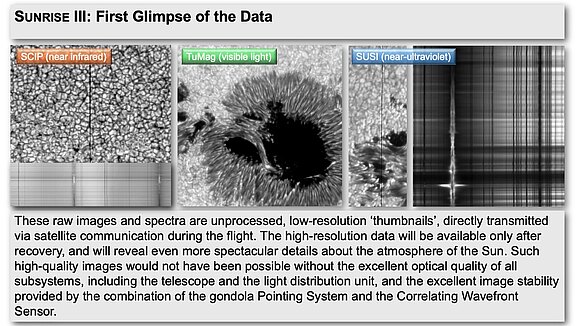The balloon-borne 1-meter solar telescope SUNRISE III, launched in the early morning hours of July 10, 2024 from the Esrange Space Center (https://sscspace.com/esrange/), the Swedish base for balloon and rocket experiments near Kiruna north of the Arctic Circle, completed its mission on the evening of July 16 with a landing in northwestern Canada.
The flight was carried out by NASA's Columbia Scientific Balloon Facility (CSBF), which had constantly provided the balloon's position and a wind-weather-based forecast for the course of the flight. The CSBF had to take many details into account in order to schedule the landing over safe terrain. The fact that the target area in northern Canada is sparsely populated was an advantage for the end of the flight.
Landing the gondola with the telescope on a parachute in a lake landscape is a challenging maneuver, especially since the landing location cannot be predicted with pinpoint accuracy from an altitude of almost 36 km due to the varying wind conditions depending on the flight altitude.
According to initial findings based on the telemetry data, the gondola had not landed in a lake and had tipped onto its back after the landing, which was cushioned by the built-in shock absorbers. Shortly after the landing, a remote sensing aircraft from the CSBF was able to confirm this finding. From the aerial photographs, it can be concluded that the gondola and the payload, including the telescope and data storage system, remained intact and can be recovered in the near future.
The mission ended with an impressive yield of around 240 terabytes of images and spectra of various objects on the surface of the sun, which in themselves provide very valuable material for scientific analysis. Together with simultaneous coordinated observations, e.g. with GREGOR on Tenerife, processes in the photosphere and chromosphere, the highly dynamic outer atmosphere of the sun, can be analyzed with very high accuracy.
The illustration shows the first images from compressed raw material transmitted via satellite during the flight, which already provide a taste of the unique quality of the images on the data carriers on board. The KIS has provided an essential component for the pointing and image stabilization.
The Sunrise mission (https://www.mps.mpg.de/sonnenforschung/sunrise-teleskop) is being led by the MPS in Göttingen.
Contact:
Dr. Thomas Berkefeld (Project Leader), Thomas.Berkefeld@~@leibniz-kis.de
Prof. Dr. Hardi Peter (Scientific Director, Institute of Solar Physics), Hardi.Peter@~@leibniz-kis.de
Dr. Reiner Volkmer, Reiner.Volkmer@~@leibniz-kis.de
Institut für Sonnenphysik (KIS)
www.leibniz-kis.de
Georges-Köhler-Allee 401a
D-79110 Freiburg
